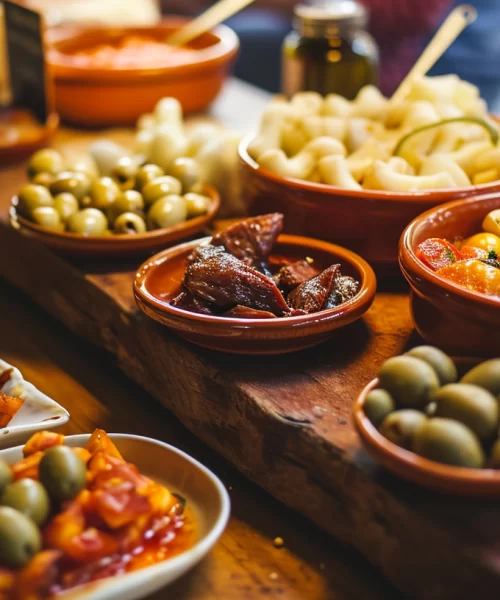The practice of preserving food is not new; the preservation of ingredients by dehydration, fermentation or salting are age-old methods. In Portugal, salted cod is one of the best-known examples of canned food, but Portuguese canned fish is not far behind, playing an important role in the country’s history and culture.
History of the Portuguese Canning
Portugal has a long tradition of canning fish. As early as the Iron Age, the method of preserving fish in sea salt was practiced in the Iberian Peninsula and used by the Phoenicians, Greeks, Carthaginians and Romans.
Ruins found along the coast, such as the Roman clay pots in Peniche, evidence of a developed salted fish industry of that period. Ancient writings also report the export of fish to Italy, Gaul and North Africa. For many centuries, salted fish remained the preferred method of preservation, but gradually drying and smoking methods became popular.
In the mid-19th century, in 1853 to be precise, the first fish canning company opened in Portugal founded. Years later, spurred on by the two great wars, Portugal greatly expanded its production, providing European countries and their soldiers with easily transportable, nutritious and durable food.
Since then, the Portuguese have been actively involved in the perfecting new preservation techniques and making the product a national specialty. The convenience of canning fish left the theater of war and entered the daily lives of Portuguese families.
In 1983, there were 152 canning factories in Portugal with an annual production of about 34,000 tons and the country was one of the largest exporters of canned fish. But shortly thereafter, in the late 1980s and into the 1990s, the canning industry experienced a terrible decline, many factories and manufacturers closed their doors and canned fish faded into the background in the Portuguese perception.
The renaissance of Portuguese canned fish
After the crisis in the 1990s, the number of canneries fell from 152 to just 20, but today they produce more than 59,000 tons of fish per year. In addition to promoting the economic and health benefits of canned fish, several manufacturers have decided to return to traditional methods and packaging, reviving the colorful and enticing hand-wrapped labels that were popular in the iconic canned fish era. With the explosion of gourmet shops in Lisbon and Porto, many canned fish manufacturers started offering boutique brands of the highest quality fish using the newly designed packaging.
Therefore, canned fish is in fashion today. Wine bars are opening in many capital cities, where canned fish play a starring role, and foodies from all over the world are looking for the best canned sardines, mackerel, tuna or cod.
Top canned fish and seafood in Portugal
Canned sardines are the best known and most traditional of Portuguese canned fish, but they are not the only ones. In Portugal almost all seafood is available canned, including squid, octopus and roe in a variety of recipes and oils. The most common canned fish in Portugal are:
- Sardines: You are the classic. Also known as sardinhas or petingas (sardines). They are available in olive oil, smoked, with tomato, lemon, pepper and many other ingredients.
- Sardine roe: also known as Portuguese caviar. They are pickled in olive oil and usually served with buttered toast. A real delicacy.
- Octopus: mostly simple seasoned with olive oil or already seasoned with garlic or tomato sauce. It’s worth eating them straight from the can or cooking them the Portuguese way by basting the potatoes with their own sauce.
- Tuna: Not comparable to the tuna you find in big supermarkets. In Portugal, there are high-quality canned tuna pieces. Try the canned tuna belly, the juiciest part of the fish.
- Mackerel: good for everything. Also known as Cavalha or Cavalinha (lesser mackerel). It is usually preserved in fillets, similar to canned tuna, but juicier and with a more intense flavor.
- Squids: This delicacy goes even further, it is practically a dish in a can, the calamari are served with a sauce based on tomato, onion, pepper and olive oil , there are also versions only with olive oil.
- Cod: Portugal should not be missed. It can be found in a variety of preparations. From the version with olive oil to more elaborate recipes such as Portuguese-style cod with garlic and oil.
How is Portuguese canned fish made?
The production of canned fish may vary from one cannery to another, but it basically consists of the following steps:
- Before the start of production, a sensory quality analysis is carried out to evaluate the smell and texture and to determine if the fish is suitable for canning. (2) Manufacturing starts with pickling the fish in brine; the duration depends on the salinity of the water and the quality of the fish or shellfish.
- the parts that are not to be preserved are removed and the Fish is canned. At this stage, sauces or oil are added until the can is completely filled, then the cans are hermetically sealed to prevent air from entering.
- Finally, the cans are sealed and heated to over 100 degrees Celsius. In this part of the process, the fish is cooked and the cans sterilized so that the product can be preserved without the addition of preservatives.
Portuguese canned fish gifts
With their vintage look and packaging that tells the story of the country, the canned sardines have become an icon of Portuguese industrial design and has become a symbol of the country’s gastronomic culture. And they make a great souvenir. Nowadays you can find tins with funny prints, retro designs, dates and historical events.
In this way, Portuguese canned fish have become one of the best-selling souvenir products for travelers to Portugal.






